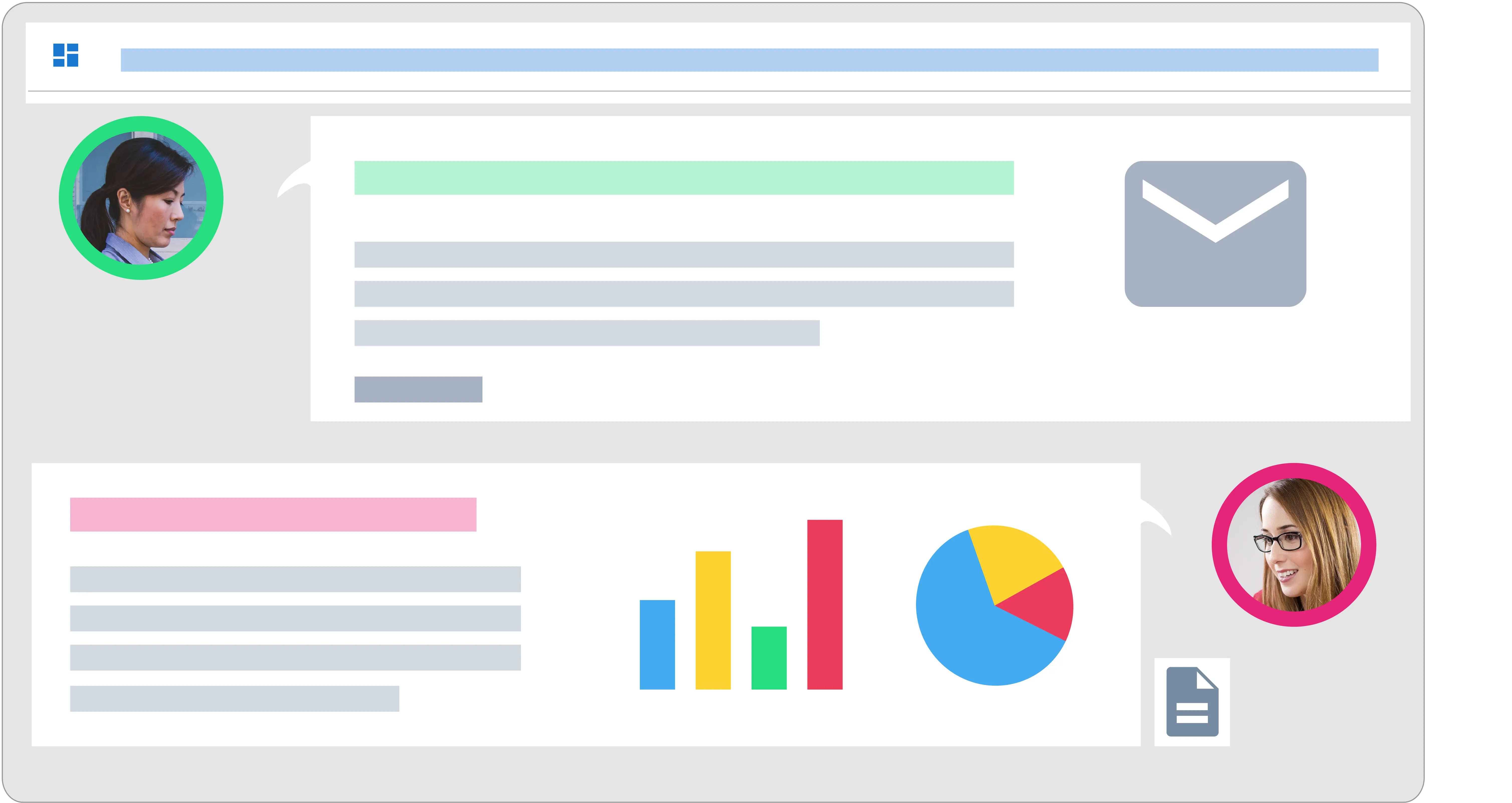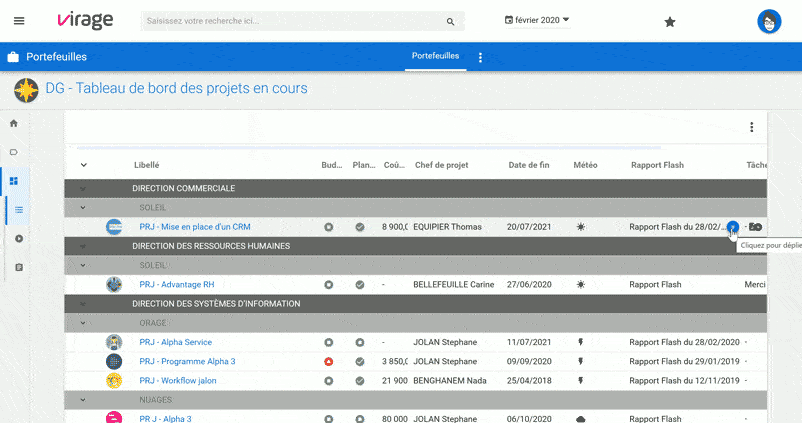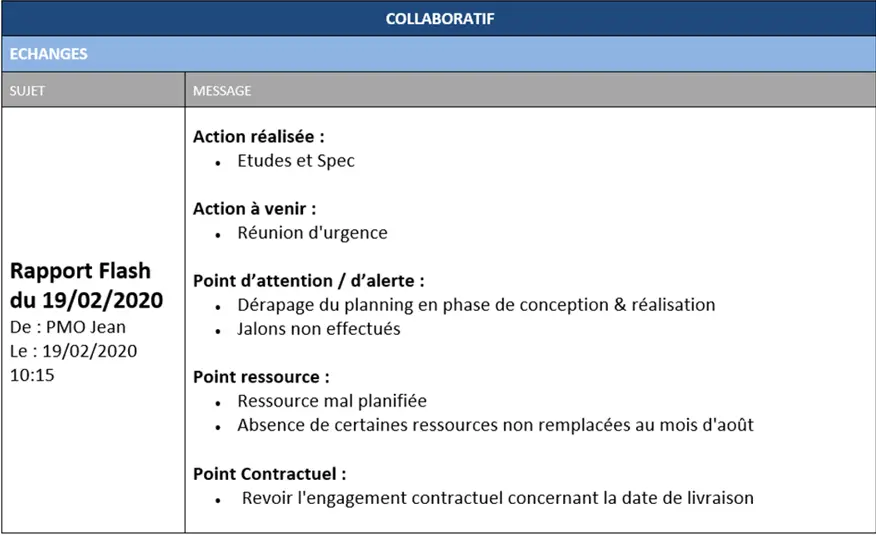The project flash report, the secret weapon of your project reviews!
Why integrate flash reports into your project reviews?
Project reviews are an essential part of Project Portfolio Management. Including a recurring status update in the form of a "flash report" is a key best practice. You have a project dashboard with performance indicators for your projects, but are these sufficient to provide a clear understanding of the situation? A progress indicator showing that a project is behind schedule may not be an alert if the situation is under control. A "time spent" indicator may be green simply because no-one has been working on the project, which is a critical point. The reality of a project is not fully described by figures. That's where the "flash report" or "flash project report" comes into its own, and provides a key nuance in understanding a project's situation. During a project review, time is of the essence, and a synthetic vision is essential. The flash report effectively combines the "literary" and "mathematical" approaches to describe the project situation. Let's find out how to integrate this secret weapon into your project portfolio governance.
Context & Timing of the flash report project
The flash report is a recurring report, the frequency of which is aligned with the bodies set up by the PMO (Project Manager Officer). Project managers feed their flash reports with qualitative information according to a structured and well-defined framework defined by the PMO. Standardization of the structure is important to facilitate information gathering.
Once the summary reports have been completed to date, the PMO gathers the content and structures a summary of all the flash reports from all the project managers' projects. The aim is to prepare a relevant summary for the steering committee (CODIR/DG/COMEX) or simply for himself.
From this summary, the steering committee can visualize the rate of progress of each project and, of course, understand the context in which these results were obtained.
For projects to be successful, the players must be constantly synchronized to date. More than 20% of a project's time is spent circulating qualitative data between the various stakeholders.
We are seeing two virtuous effects from the ritualization of project flash reports. In addition to drastically reducing the duration of project reviews, the quality of project data is significantly improved. And it boosts project progress - our project managers don't like to point out that nothing has happened, so they make sure that things move forward...
Easily create flash reports with Project Monitor

Start by choosing project management software that integrates this function for project managers, PMOs, CIO and general management. This will make it easy to create and personalize qualitative flash reports on all projects.
The Project Monitor solution offers this collaborative function, making it easy to write and distribute flash reports.
- A simple and effective status report
- Easy to create from template
- Easy to update
- Easy to ritualize with your project managers
- Easy to develop collaboratively
- Easy to distribute via e-mail and dashboard
In practice, here's how you can easily organize your project review:
- A few days before the steering committee meeting, project managers receive an e-mail notification telling them to submit a new flash report for their project.
- By accessing the project flash report, the information to be completed for the committee is already pre-filled according to a standard template, with the essential kpis. The project manager reports and updates project indicators.
- Data is consolidated in real time. In just a few clicks, he can prepare and personalize his report. The PMO saves preparation time, and has direct access to the shared project dashboard.
- The flash report is synthetic, exportable and collaborative, enabling it to be shared with all project collaborators and stakeholders.
Request a demonstration of your project
Define your flash report model and performance indicators
Let's not forget that a project is characterized by a precise and unique objective to be achieved, actions to be carried out, human and financial resources to be mobilized, with a well-defined start and end date. To communicate, assess and mobilize on all these facets of the project, "flash reports" on regular dates are very effective.
The "Flash report", as its name suggests, is a brief document whose aim is to provide a macro and synthetic vision of projects on a given date. It is an essential tool for gaining a good understanding of projects. It is therefore a project review reporting document used by the Steering Committee.
In every project, project managers track performance indicators, known as KPIs (Key Performance Indicators). It's vital to explain why and how they arrived at a given situation, and to share the next steps...
There's nothing like a status report to communicate a few decisive qualitative factual elements; a "temperature check" of project progress, as it were.
In addition to the automatically calculated indicators (budget, schedule, resources), the flash report can accompany the analysis. This information is more subjective, based on feelings, and helps to give greater meaning to the KPIs.
To speed up meeting preparation and information gathering, select a flash report template that will automatically fill in the indicators to be analyzed.
This project to date is a summary report of a few comments that will specify, for example:
- actions taken
- upcoming actions
- warning and attention points
- resource centers
- contractual points
Example of the integration of flash project reports in Project Monitor
Flash report integrated into the project review dashboard. Direct access from the project review provides additional information on the project.

Example of a typical flash report structure obtained from a template which the Project Manager initiates from the project area and which enables him to complete the project KPIs.

Flash decision making project report
At the Steering Committee meeting, this monthly update reviews all projects. The decisions made on the basis of the calculated indicators coupled with the flash report is a crucial moment in the future progress of project management.
Management reviews all projects, alerts, encourages and implements actions to support, prevent and/or refocus.
80% of steering groups make decisions immediately after assimilating the contextual elements.
These actions give new impetus to projects in the area of progress.
What's surprising is that the word Flash says it all: "A device that produces intense light for a very short period of time. Behind this word we find a notion of speed, bright light and intensity...".
These flash indicators significantly improve the progress of your projects.
Clearly, taking the temperature of your projects' progress is one of the keys to success.
Webinar: How did Würth reduce project review times by a factor of 3?
The QQOQCP of the flash report :
Finally, the flash report QQOQCP sheet to make sure you don't forget anything about this key project governance tool:
What: a synthetic, standardized vision of the project combining indicators and structured text
Who: drafted by the project manager in collaboration with his project team, validated and compiled by the PMO
When: frequency to be determined by steering committee. At least monthly. Frequency can be weekly.
Where: ideally in a dedicated function integrated into the project portfolio management tool. At the very least, an office file sent by e-mail.
How: with a standard model applied (or even imposed) to all projects.
Why: a tool for gathering information on a project's situation. It triggers and enables decision-making. It's your project managers' secret weapon for saving time and improving efficiency.